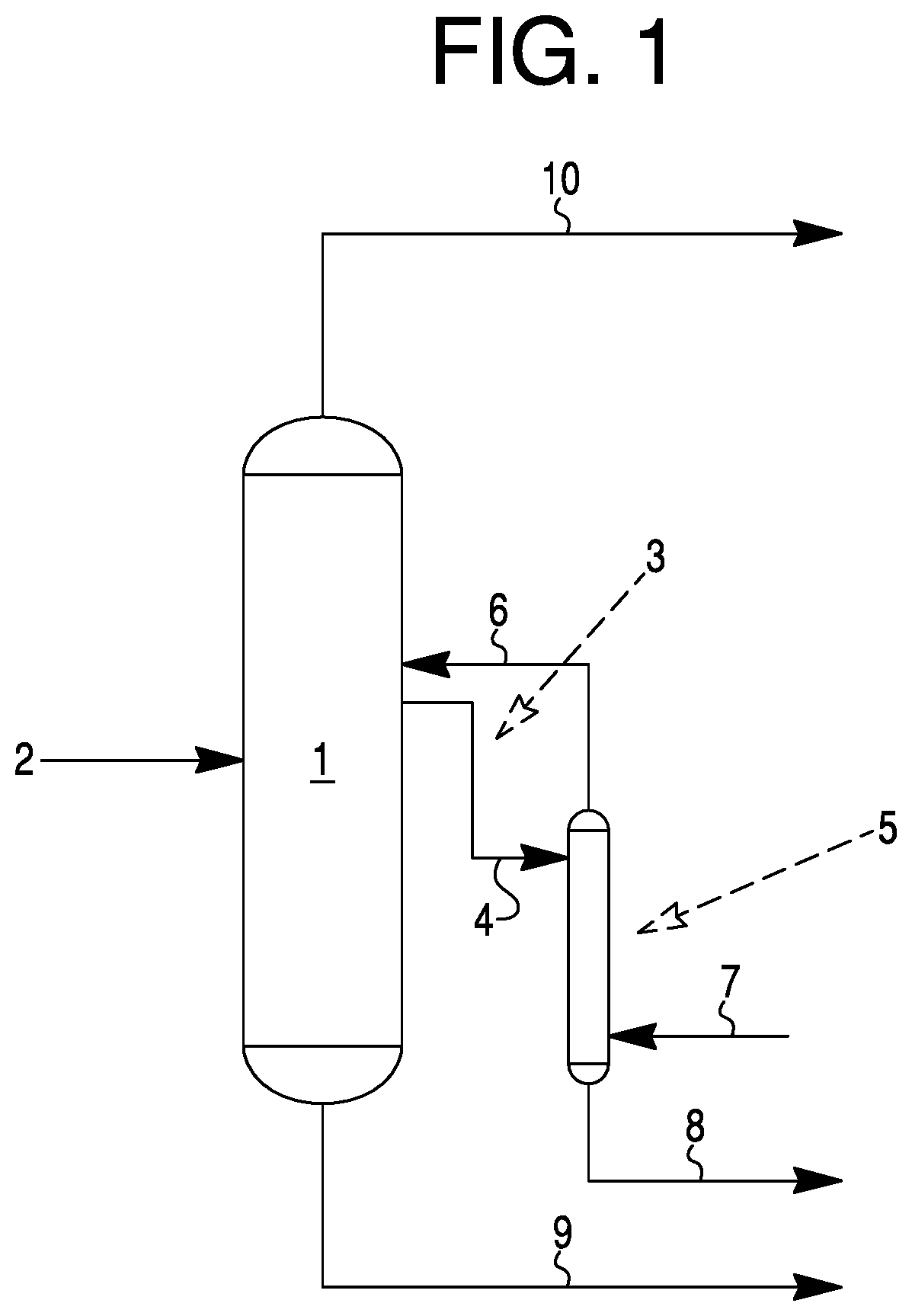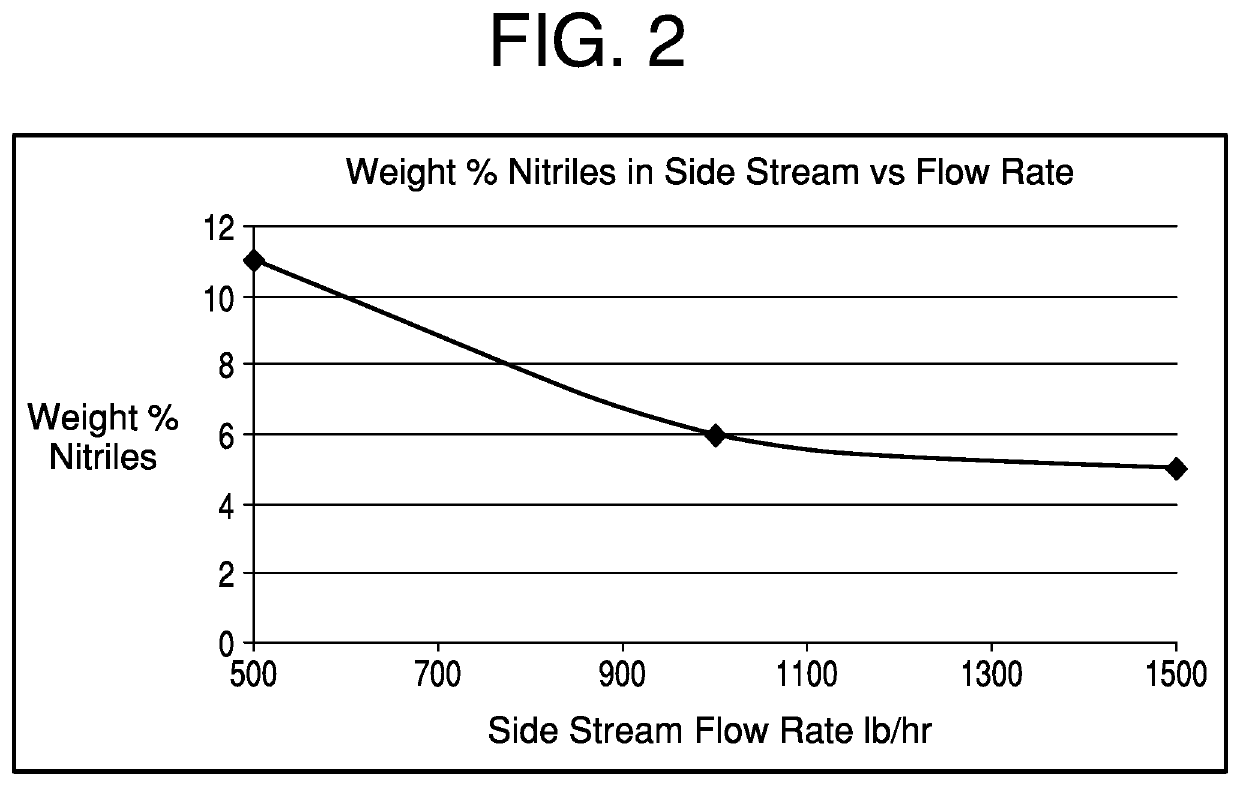Method for removing nitriles from hydrogen cyanide
a technology of hydrogen cyanide and nitrile, which is applied in the field of removing nitriles from hydrogen cyanide, can solve the problems of product loss, production interruption, and occasional loss of product purity, and achieve the elimination of loss of hcn through purging of separation and purification equipment, and marked reduction of buildup of organonitriles in process equipment.
- Summary
- Abstract
- Description
- Claims
- Application Information
AI Technical Summary
Benefits of technology
Problems solved by technology
Method used
Image
Examples
example 1
m Stripper Feed Rate=500 Pounds Per Hour
[0030]With a feed rate of 500 pounds per hour, the composition of the feed stream (3) to the Sidestream Stripper Column would have the following concentrations on a mass % basis:
[0031]
ComponentMass %HCN51.792%Acrylonitrile1.156%Acetonitrile9.826%Propionitrile0.269%H2O36.957%
[0032]The total nitriles in the side stream purge would be 11.25%.
[0033]The composition of the HCN stream (6) that leaves the Sidestream Stripper and is returned to the HCN purification equipment would be:
[0034]
ComponentMass %HCN91.081%ACRN0.831%ACEN2.610%PROPN0.071%H2O5.406%
[0035]The composition of the Nitriles Purge stream (8) would be:
[0036]
ComponentMass %HCN0.001%ACRN1.584%ACEN19.338%PROPN0.531%H2O78.546%
example 2
el—Sidestream Stripper Feed Rate=1,000 Pounds Per Hour
[0037]With a feed rate of 1,000 pounds per hour, the composition of the feed stream (3) to the Sidestream Stripper Column would have the following concentrations on a mass % basis:
[0038]
ComponentMass %HCN46.340%Acrylonitrile0.997%Acetonitrile5.032%Propionitrile0.140%H2O47.490%
[0039]The total nitriles in the side stream purge would be 6.17%.
[0040]The composition of the HCN stream (6) that leaves the Sidestream Stripper and is returned to the HCN purification equipment would be:
[0041]
ComponentMass %HCN91.361%ACRN1.293%ACEN1.662%PROPN0.049%H2O5.635%
[0042]The composition of the Nitriles Purge stream (8) is:
[0043]
ComponentMass %HCN0.001%ACRN0.693%ACEN8.501%PROPN0.233%H2O90.571%
example 3
el—Sidestream Stripper Feed Rate=1,500 Pounds Per Hour
[0044]With a feed rate of 1,500 pounds per hour, the composition of the feed stream (3) to the Sidestream Stripper Column would have the following concentrations on a mass % basis:
[0045]
ComponentMass %HCN44.071%Acrylonitrile1.042%Acetonitrile3.401%Propionitrile0.095%H2O51.391%
[0046]The total nitriles in the side stream purge would be 4.54%.
[0047]The composition of the HCN stream (6) that leaves the Sidestream Stripper and is returned to the HCN purification equipment would be:
[0048]
ComponentMass %HCN91.327%ACRN1.687%ACEN1.237%PROPN0.038%H2O5.712%
[0049]The composition of the Nitriles Purge stream (8) would be:
[0050]
ComponentMass %HCN0.001%ACRN0.440%ACEN5.420%PROPN0.149%H2O93.991%
PUM
| Property | Measurement | Unit |
|---|---|---|
| temperatures | aaaaa | aaaaa |
| temperatures | aaaaa | aaaaa |
| heat | aaaaa | aaaaa |
Abstract
Description
Claims
Application Information
 Login to View More
Login to View More - R&D
- Intellectual Property
- Life Sciences
- Materials
- Tech Scout
- Unparalleled Data Quality
- Higher Quality Content
- 60% Fewer Hallucinations
Browse by: Latest US Patents, China's latest patents, Technical Efficacy Thesaurus, Application Domain, Technology Topic, Popular Technical Reports.
© 2025 PatSnap. All rights reserved.Legal|Privacy policy|Modern Slavery Act Transparency Statement|Sitemap|About US| Contact US: help@patsnap.com


